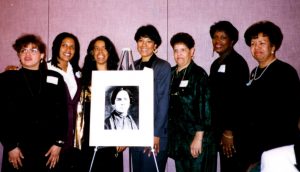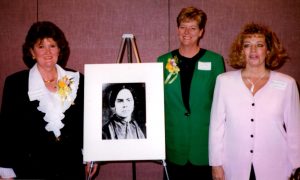An African American trailblazer with local roots seems more suited to modern times than life 150 years ago.

Photo courtesy of the National Archives of Canada
Mary Ann Shadd Cary worked as a teacher, journalist, editor, lecturer, lawyer, civil rights activist, suffragette, abolitionist, wife and mother, fitting the profile of today’s super woman. Her accomplishments proved even more remarkable for a woman of color, making her a worthy subject for anyone inspired to research area notables during Black History Month.
Shadd Cary’s family roots date back to 1755, before America’s founding, according to Jane Rhodes, whose research led to the publication of Mary Ann Shadd Cary: The Black Press and Protest in the Nineteenth Century in 1998. Rhodes offers the following account of Shadd Cary’s journey from Delaware to Canada to Washington, D.C.:
In the year leading up to the French and Indian War, a Hessian mercenary under the command of General Braddock was wounded and sent to Chadds Ford to recuperate. His nurses were a free black woman, Elizabeth Jackson, and her daughter, also named Elizabeth. The younger Elizabeth and the soldier, Hans Schad, fell in love and married. The couple had two sons, Hans Jr. and Jeremiah, and eventually moved just over the Pennsylvania-Delaware line to Millcreek Hundred. Over time, the spelling of the family name changed to Shad and then to Shadd.
One of Jeremiah Shadd’s sons, Abraham (1801-1882), became a leader in Wilmington’s community of free blacks. He was a delegate to annual conventions for free blacks and served as president. He was also a delegate to Anti-Slavery Society conventions, where he met and formed lasting friendships with Pennsylvania Quakers. Working with Wilmington Quaker Thomas Garrett, he helped fugitive slaves travel through the northern Delaware portion of the Underground Railroad.

Abraham Shadd’s 13 children grew up in a home centered on social activism, and as adults they all chose careers that gave them the opportunity to improve conditions for their race and fellow citizens. Among the activist children, though, Mary Ann Shadd was the most outstanding.
The eldest child, she was 10 years old when the family, with help from their Pennsylvania Quaker friends, moved to West Chester. The move made it possible for all the Shadd children – the boys and the girls – to receive an education, something that was not possible at that time in Delaware. Their father continued to prosper in business and became a leader in his new community.
Through her teacher, Phoebe Darlington, Mary Ann Shadd learned the values of the Society of Friends, including the brotherhood of man and the importance of education. When her studies were complete, she taught in several area schools while sharing her strong opinions about integration, slavery, and education in various newspapers. Casting her net further, she wrote a short pamphlet called, “Hints to the Colored People of the North” in 1949 in which she encouraged thrift and encouraged her readers to live within their means. The pamphlet caught the attention of Frederick Douglass, and soon she began writing articles on black independence and need for self-respect for his North Star publication.
Writer W.E.B. Du Bois described Mary Ann Shadd as “tall, slim and beautiful, having that ravishing dream-born beauty – that twilight of races that we call mulatto.” For her part, Shadd preferred not to think about her color and, when discussing color, referred to people as having “complexional differences.” By all accounts, her beauty, combined with her intellect and strong personality, made her remarkable in any setting. Although she could be abrasive, her arguments often sparkled with wit and humor.

With the passage of the Fugitive Slave Law of 1850, many blacks – those free-born and those “self-emancipated” – chose to leave the U.S. and settle just across the Detroit River in Canada. In “Canada West,” they could finally live without the constant fear of being sold into slavery in the South. It was to this safe haven that the entire Shadd family moved in 1852. Almost immediately, Mary Ann Shadd began to teach in a makeshift school, and with her brother Isaac, founded a newspaper to serve the immigrant population.
Called “The Provincial Freeman,” the paper’s masthead declared, “Self-reliance is the True Road to Independence.” During this same period of time, she wrote another pamphlet, printed in Wilmington, which extolled the advantages for blacks living in Canada. Ignoring the danger of travelling alone, Mary Ann Shadd lectured throughout the U.S., promoting immigration and selling her booklet, “Notes on Canada West.”
In 1856, Shadd took time out from her hectic schedule to marry a politically active Toronto barber originally from Virginia, Thomas Cary. Cary had three children from a previous marriage and added two more children to the family with his new wife. By 1860, “The Provincial Freeman” had stopped printing, and Thomas Cary had died, leaving his widow with five children to support.
To earn extra income and to support the Union cause, Shadd Cary accepted a commission to recruit black soldiers for the Union Army, excelling once again in her duties. After the Civil War, she and her children moved to Washington, D.C. Here, Shadd Cary taught children who were part of the huge migration of black families to that city following the end of the war. She continued her fiery writing and was a frequent contributor to Frederick Douglass’ “New National Era” and John Wesley Cromwell’s “The Advocate.“
Shadd Cary’s attention next turned to the issue of women’s suffrage. She became involved with the National Women’s Suffrage Association, where Susan B. Anthony and Lucretia Mott recognized her as a gifted speaker and invited her to address the association’s convention in 1878. Later, she appeared with Cady Stanton and Anthony to argue before Congress that the 14th and 15th Amendments provided the right to vote to all its citizens and taxpayers.

At age 46, Shadd Cary entered Howard University’s newly established Law School with 45 other students. Research suggests that she was the first African American woman to study law and one of the first American women of any race to seek a law degree. Although she excelled in her courses, curiously she did not graduate with the 10 students who finished the program. Many explanations have been proffered, but it couldn’t have helped that the legal profession at that time was a white, male-dominated profession in the 1800s, and it was difficult for women across the country to get admitted to the bar.
Shadd Cary was 60 years old when she finally became a lawyer. With her license in hand, she focused on serving the downtrodden in her community until her death in 1893 at the age of 70. Several years earlier, Bishop Daniel Payne of the African Methodist Episcopal Church wrote that, “her energy and perseverance, as well as her ability to suffer in the causes she espoused, entitled her to rank among the reformers of the time. She left to others to carry forward the torch she had ignited.”
In recognition of her important contributions to the educational and economic advancement of blacks and women, her Washington, D.C. home, 1421 W. Street, NW, was placed on the National Register of Historic Places in 1976. In 1997, she was inducted into the Hall of Fame of Delaware Women, and in 1998, she was inducted into the National Women’s Hall of Fame in Seneca Falls, N.Y. Shadd descendants came from across the U.S. and Canada to witness the proud moment in their family history – a journey that began in Chadds Ford when a wounded Hessian soldier was nursed back to health 260 years ago.
About Lora B. Englehart
Lora has a passion for art, gardening, yoga, music and dancing. She continues to research the life of locally born abolitionist and 1998 National Women's Hall of Fame inductee Mary Ann Shadd Cary. She is a dedicated community volunteer, working with the American Association of University Women, Wilmington, DE branch (programs chair), Chadds Ford Historical Society (former board member) and Brandywine Conservancy & Museum of Art. Lora lives in Birmingham Township with her husband Bill and son Brad. Daughter Erika lives in Pittsburgh with husband Bob and baby Wilhelmina. She is a former French, Spanish and ESL teacher, bilingual life insurance underwriter and public relations coordinator for Delaware Art Museum and Brandywine Conservancy & Museum of Art.


Comments